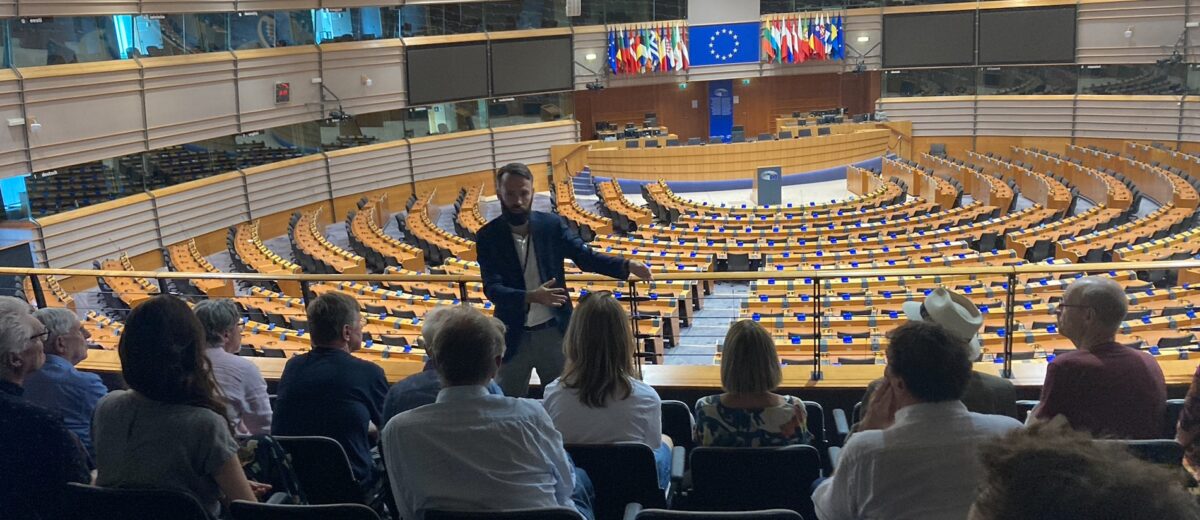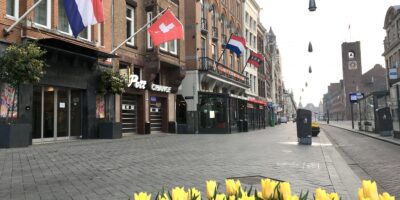Early this week I tagged along with a group of thirty Dutch visitors to Brussels on a walking tour of the European sector led by two experienced Dutch journalists, Bert and Tijn.
For most of those I talked with in the group, Brussels was a fairly unfamiliar city. For widely different reasons, they had responded to the invitation from the website, Brusselse Nieuwe, for a glimpse behind the scenes of the power in Het Brusselse Moeras (the ‘Brussels swamp’), the title of a book the journalists had authored.
Although I have been involved with Brussels now for over thirty years, and have taught classes on the history and workings of the various EU institutions, I wanted to learn fresh perspectives through the eyes of others. Bert and Tijn told anecdotes about the seamy side of Brussels, of the power struggles between oversized egos, of interns and political scalpers, and about the ‘Prince of Darkness’ – a powerful and well-entrenched civil servant known for manipulating decisions from behind the scenes.
Their reference to the swamp was intended both figuratively and literally. The Maalbeek, once an open sewer flowing through the city, was diverted underground in 1872. However it continues to wreak damage to buildings in the city. ‘Maalbeek’ is the name of the metro station in the European sector reknowned for the suicide bomb attack which killed 35 people in 2016.
The European Parliament building, with its circular auditorium for parliamentary gatherings, is built right over the Maalbeek-swamp. Recently the building was discovered to be sinking –about one centimetre each year. Which means that in the underground parking areas, mould is growing on the walls, and buckets are strategically placed to catch the seeping water. The whole future of the EP buildings is uncertain.
Which is how many Eurosceptics view the future of the European project. For them, the swamp image confirms their fears and criticisms of ‘Brussels’, the unofficial capital of Europe, fed by the populism and nationalism of recent years. Of course, any hub attracting powerful egos, gold-diggers and huge sums of money will offer material for muck-raking journalists.
Yet the French philosopher and Christian thinker Blaise Pascal perceptively observed that ‘in faith there is enough light for those who want to believe and enough shadows to blind those who don’t.’ Likewise, in Brussels there is much room for interpretation according to our preconceptions. Brussels reflects the wide range of ideas, ideologies and philosophies which have emerged over centuries of European history.
Truncated
Some of these are reflected in the much-trumpeted House of European History, set in a park behind the European Parliament. Attempting to provide a welcome Europe-centred perspective as an alternative to the nation-centred histories most of us grew up with, it unfortunately offers a very truncated view of the roots of Europe and European values. After a brief presentation of the Greek myth of Europa and Zeus, visitors are introduced to the Enlightenment and human rights, skipping the historical fact that Europe first emerged as a community of peoples professing the Christian faith, the true source of human rights.
My view of Brussels was enriched however as we walked from Luxembourg Square and the European Parliament buildings past sites of various Permanent Representatives (that is, national embassies to the EU, of which there are 27), numerous media buildings which channel news and opinions into 24 official languages, other buildings facilitating efforts of provinces of member states all lobbying for grants, as well as the ubiquitous restaurants where deals are incubated. Brussels facilitates a constant cauldron of conversation between member states and EU institutions, and even non-member states, on issues affecting our daily lives in Europe and beyond. Churchill’s words came to mind: ‘Jaw, jaw, jaw is better than war, war, war.‘
Eventually we climbed the stairs to emerge at the building of the Council of the European Union. Here ministers of member states regularly meet their counterparts to decide on proposals designed by the European Commission in the Berlaymont building right across the road. Commission president, Ursula van der Leyen, who delivered her State of the European Union address this week in Strasbourg to open the parliamentary year, lives and works on the top floor of Berlaymont, looking out on the Robert Schuman Roundabout.
Ah, Schuman! His name had not yet been mentioned.
Defining moment
It was in the basement of Berlaymont in 1991 when I first heard the Schuman story, told by a Christian official of what was then the European Community. Schuman was the key figure in the story of forgiveness and reconciliation, primarily between the French and the Germans, without which European integration would never have begun. He was recognised as the ‘Father of Europe’ when he stepped down from being the first president of the predecessor of the current European Parliament.
At one point, Europe Day was mentioned in passing. I had the opportunity at the end of the tour to ask who of our group knew what or when Europe Day was. Other than Bert and Tijn, no one knew. Yet, in my perspective, Europe Day, May 9, represents the defining moment of post-war European history. It commemorates the three-minute speech Robert Schuman made on this date in 1950 which triggered the process of European integration and has led to the EU today. It began the draining of the swamp of hatred, bitterness and brokenness widespread across post-war Europe. The speech proposed cooperation and solidarity towards the common good and world peace. In less time than it takes to make a cup of coffee, Schuman laid the foundations of the European house in which today 450 million Europeans live together in peace. It’s a day celebrated by grateful newer members of the EU, yet sadly, totally ignored in the Netherlands, for example.
I like to call it Interdependence Day, a day to celebrate being part of the European family of peoples, made possible through forgiveness and reconciliation, following Schuman’s example. Despite Brexit, integration and European solidarity has regained momentum, largely in response to Putin’s aggression.
So there’s another story to tell about Brussels. Would you be interested in joining me in the spring on such a tour, starting with the Schuman story, learning about the work of some of the Christian lobby groups and finishing in the Parliamentarium, an interactive museum exploring how together, through dialogue, we can all help shape Europe’s future?
If so, let me know and I’ll keep you informed.
Till next week,



